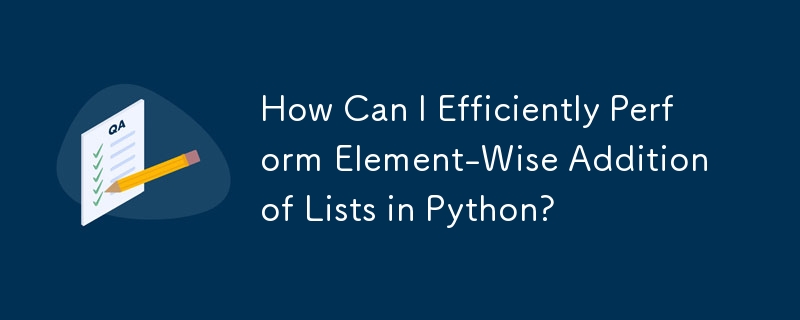Home >Backend Development >Python Tutorial >How Can I Efficiently Perform Element-Wise Addition of Lists in Python?
How Can I Efficiently Perform Element-Wise Addition of Lists in Python?
- Linda HamiltonOriginal
- 2024-12-05 06:58:14851browse

Element-Wise Addition of Lists: Pythonic Efficiency
When manipulating lists, the need to perform element-wise operations often arises. Consider the task of adding elements of two lists positionally, as shown below:
list1 = [1, 2, 3] list2 = [4, 5, 6]
The desired output is:
[1, 2, 3] + + + [4, 5, 6] || || || [5, 7, 9]
To achieve this element-wise addition, several Pythonic approaches exist:
Method 1: operator.add and map
The operator.add module provides the necessary functionality for element-wise addition. By utilizing the map function, you can iterate through both lists simultaneously and apply the add operation:
from operator import add result = list(map(add, list1, list2))
Method 2: zip and List Comprehension
The zip function combines elements of lists into tuples, which can be further manipulated in a list comprehension. This approach involves extracting values from the tuples and summing them:
result = [sum(x) for x in zip(list1, list2)]
Performance Considerations
The choice of method may depend on performance requirements. The following timing comparisons indicate that the map(add, list1, list2) approach is the fastest for large lists. The zip-based methods are slower due to the additional tuple manipulation.
For instance, with lists containing 100,000 elements each:
%timeit from operator import add;map(add, list1, list2) 10 loops, best of 3: 44.6 ms per loop %timeit from itertools import izip; [a + b for a, b in izip(list1, list2)] 10 loops, best of 3: 71 ms per loop %timeit [a + b for a, b in zip(list1, list2)] 10 loops, best of 3: 112 ms per loop
For more complex operations, additional methods may be required. However, for the simple task of element-wise addition, the approaches outlined above provide the most Pythonic and efficient solutions.
The above is the detailed content of How Can I Efficiently Perform Element-Wise Addition of Lists in Python?. For more information, please follow other related articles on the PHP Chinese website!

